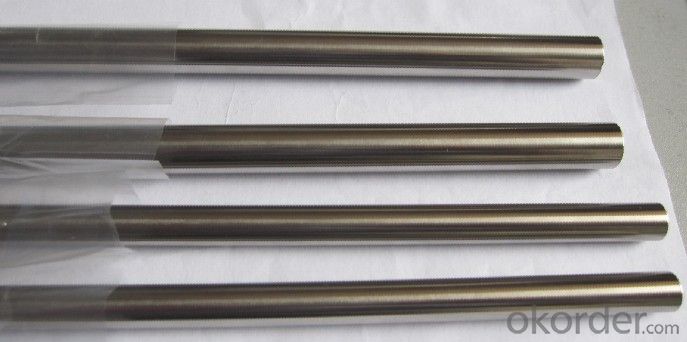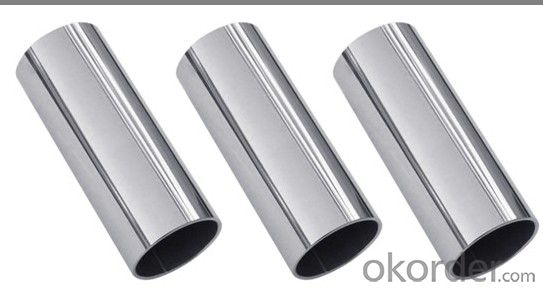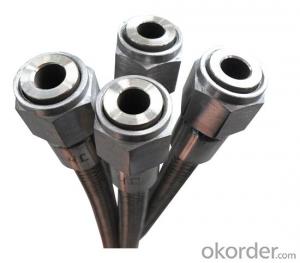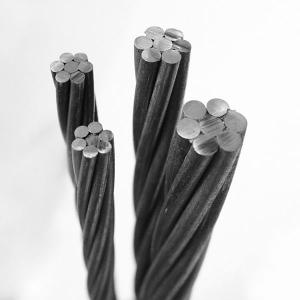A335 Seamless Ferritic Alloy-Steel Pipe for High-Temperature Service
- Loading Port:
- Shanghai
- Payment Terms:
- TT OR LC
- Min Order Qty:
- 1000 kg
- Supply Capability:
- 10000 kg/month
OKorder Service Pledge
OKorder Financial Service
You Might Also Like
(1) nominal wall and minimum wall seamless ferritic alloy-steel pipe intended for high-temperature service. Pipe ordered to this specification shall be suitable for bending, flanging (vanstoning), and similar forming operations, and for fusion welding.
(2)Each length of pipe is subjected to the hydrostatic test and examined by a non-destructive examination method in accordance to the required practices. The range of pipe sizes that may be examined by each method is subjected to the limitations in the scope of the respective practices. The different mechanical test requirements for pipes has been passed.
(3)Ferritic steels are defined as low- and intermediate-alloy steels containing up to and including 10 % chromium.
ASTM A335 Seamless Alloy-Steel Pipe
Standard: BS 1139, BS 3059-2, JIS G3454-2007
Grade: 10#-45#, 15NiCuMoNb5, 10Cr9Mo1VNb
Detailed introduction to ASTM A335 seamless alloy steel pipe:
ASTM A335 seamless alloy steel pipe
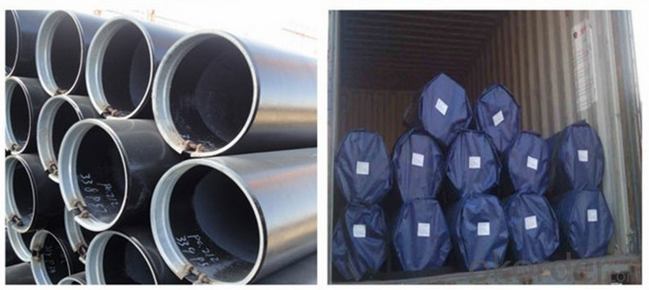
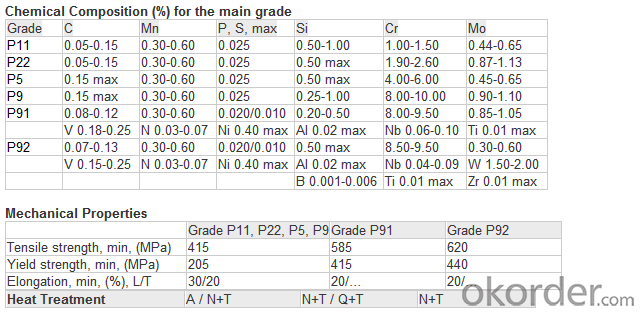
FAQ:
1) why you chose us ?
Professional Manufacturer and supplier of Steel pipe
More than 14 years’ professional producing experience
We can get the lowest ex-factory prices. The price are quite reasonable and it is lower than our commercial peers. also, we can guarantee the qualities of our products.
BV, ISO certificates and SGS test can be provided to assure the quality of our products.
2) Our minimum order quantity:
10 Metric Tons or one 20ft or 40ft Container.
3) How about the Delivery Time?
The steel pipe will be produced since we getting your deposit by T/T or Your original L/C. For normal size, some stocks in our factory now, we can supply once you need.
4)What kind of payment does your company support?
T/T, 100% L/C at sight, Cash, Western Union are all accepted.
5) Do you charge for the samples?
According to our company principle, we just charge for samples, you pay for the freight /courier charge.
6) Main market:
Mid East, South America, Africa, Southeast Asia, India etc
- Q:How are stainless steel pipes manufactured?
- The production of stainless steel pipes involves a complex and careful procedure comprising several stages of fabrication and shaping. Initially, high-quality stainless steel sheets or coils are chosen and thoroughly examined for any flaws or imperfections. Subsequently, these sheets are cut into the desired dimensions. Once the sheets are cut, they are fed into a forming machine where they are rolled into the shape of a cylindrical tube. This rolling process, known as cold rolling, establishes the initial form and thickness of the pipe. The rolled sheets are then welded together using either high-frequency induction welding or submerged arc welding techniques, both of which guarantee robust and long-lasting weld joints. After the welding process, the pipe undergoes a series of finishing treatments to enhance its visual appearance and physical characteristics. Initially, excess weld material is removed using a trimming machine to achieve a smooth and uniform surface along the entire length of the pipe. Next, the pipe is subjected to an annealing heat treatment, which relieves internal stresses and improves the mechanical properties of the pipe. Additionally, annealing enhances the stainless steel's resistance to corrosion. Subsequent to annealing, the pipe may undergo additional processes such as pickling and passivation. Pickling involves submerging the pipe in an acid solution to eliminate surface impurities and oxides. Conversely, passivation involves treating the pipe with a chemical solution to create a protective oxide layer on the surface, thereby improving its resistance to corrosion. Once the finishing treatments are completed, the pipes are cut to the desired length and subjected to a final inspection to ensure quality assurance. This inspection includes checking dimensions, surface finish, weld integrity, and overall appearance. In conclusion, the production of stainless steel pipes entails a meticulous process involving cutting, forming, welding, finishing treatments, and quality control measures. This meticulous approach guarantees that the pipes meet the required standards and exhibit superior properties such as strength, durability, and resistance to corrosion.
- Q:Can stainless steel pipes be used for mining and mineral processing applications?
- Yes, stainless steel pipes can be used for mining and mineral processing applications. Stainless steel is known for its excellent corrosion resistance, which makes it highly suitable for use in environments where there is exposure to chemicals, acids, and high temperatures, all of which are common in mining and mineral processing operations. Stainless steel pipes offer several advantages in these applications. Firstly, their resistance to corrosion ensures that they can withstand the harsh conditions present in mining and mineral processing, thereby reducing the risk of pipe failure and minimizing maintenance and replacement costs. Additionally, stainless steel pipes are highly durable and have a long lifespan, making them cost-effective in the long run. Furthermore, stainless steel pipes are non-reactive and do not contaminate the materials being transported, which is crucial in mining and mineral processing where the purity of the products is essential. This makes stainless steel pipes suitable for conveying various minerals, ores, and chemicals without compromising their quality or causing contamination-related issues. Another advantage of stainless steel pipes is their versatility. They can be manufactured in various sizes, shapes, and thicknesses to meet the specific requirements of mining and mineral processing applications. Additionally, stainless steel pipes can be welded, threaded, or coupled to easily connect with other components and systems, allowing for efficient installation and integration into existing infrastructure. In conclusion, stainless steel pipes are well-suited for mining and mineral processing applications due to their corrosion resistance, durability, non-reactivity, and versatility. They offer a reliable and cost-effective solution for conveying various materials in a demanding environment while maintaining the integrity and purity of the products being processed.
- Q:What are the different grades of stainless steel used in pipes?
- There are several different grades of stainless steel used in pipes, including 304, 316, 321, and 409. These grades vary in their chemical composition and properties, making them suitable for different applications and environments.
- Q:Can stainless steel pipes be used in high-pressure applications?
- Yes, stainless steel pipes can be used in high-pressure applications. Stainless steel is known for its strength, durability, and ability to withstand extreme pressure conditions. It is often used in industries such as oil and gas, chemical processing, and power generation, where high-pressure environments are common. Stainless steel pipes offer excellent resistance to corrosion, making them suitable for long-term use in high-pressure applications.
- Q:Are stainless steel pipes suitable for fertilizer industries?
- Fertilizer industries find stainless steel pipes to be suitable. Stainless steel possesses a high level of corrosion resistance, a crucial characteristic for industries where pipes regularly encounter corrosive substances like fertilizers. Moreover, stainless steel pipes exhibit exceptional strength and durability, enabling them to withstand the demanding conditions of fertilizer production. Their smooth inner surface prevents the accumulation of sediments and impurities that might compromise fertilizer quality. Additionally, stainless steel pipes are effortless to clean and maintain, meeting the hygiene and safety standards mandated by the fertilizer industry. All in all, stainless steel pipes are an outstanding choice for fertilizer industries due to their corrosion resistance, strength, durability, and ease of maintenance.
- Q:Are stainless steel pipes suitable for wastewater treatment plants?
- Yes, stainless steel pipes are highly suitable for wastewater treatment plants. They offer excellent corrosion resistance, durability, and strength, ensuring long-term reliability and minimal maintenance requirements. Stainless steel pipes can withstand the harsh and corrosive conditions found in wastewater treatment plants, making them an ideal choice for conveying and handling various types of wastewater.
- Q:What's the difference between cold drawn steel tube and hot rolled steel tube?
- Cold drawn steel tubes are produced by drawing, extruding, piercing and the like. The whole steel pipe has no seams. It's a round, square, rectangular steel with a hollow cross section without any seams. It is made of steel ingot or solid pipe blank by piercing and then made by cold casting.
- Q:How are stainless steel pipes graded?
- The quality and suitability of stainless steel pipes are determined by various factors, resulting in their grading. The grading system takes into consideration factors such as chemical composition, mechanical properties, and manufacturing process. When grading stainless steel pipes, a crucial aspect is their chemical composition. This refers to the specific elements present in the alloy and their quantities. Common elements found in stainless steel pipes are chromium, nickel, molybdenum, and carbon. The percentage of these elements affects the strength, durability, and corrosion resistance of the pipes. Different grades of stainless steel pipes have different compositions, allowing them to be used in various environments and applications. Another factor considered in grading stainless steel pipes is their mechanical properties, including tensile strength, yield strength, and elongation. These properties determine how the pipes perform under different conditions and their structural integrity. Higher grades of stainless steel pipes generally possess superior mechanical properties, making them suitable for applications involving high pressure and temperature. The manufacturing process also plays a vital role in grading stainless steel pipes. The pipes undergo processes such as hot rolling, cold rolling, and heat treatment to shape them and enhance their properties. The quality of the manufacturing process greatly impacts the final grade of the stainless steel pipes. Pipes produced using advanced techniques and strict quality control measures are usually assigned higher grades. In conclusion, stainless steel pipes are graded based on their chemical composition, mechanical properties, and manufacturing process. These grading criteria ensure that different grades of stainless steel pipes are available to meet the specific requirements of different industries and applications.
- Q:What is the difference between 904L and 316L stainless steel pipes?
- The composition of 904L and 316L stainless steel pipes sets them apart. 904L contains higher amounts of chromium, nickel, and molybdenum compared to 316L. Specifically, 904L has about 25% nickel and 4.5% molybdenum, while 316L contains approximately 10-14% nickel and 2-3% molybdenum. In terms of corrosion resistance, 904L stainless steel pipes outperform 316L due to their higher chromium, nickel, and molybdenum content. The increased alloying elements make 904L more resistant to localized corrosion, such as pitting and crevice corrosion, particularly in aggressive environments like seawater and acidic conditions. When it comes to strength and toughness, 904L stainless steel pipes have the upper hand over 316L. This makes them more suitable for applications requiring greater mechanical properties, like high-pressure and high-temperature environments. In terms of cost, 904L stainless steel is generally pricier than 316L due to its higher alloying elements. The increased cost is mainly due to the higher nickel and molybdenum content, which are more expensive metals. 316L stainless steel pipes find common usage in various industries, such as food processing, chemical processing, and pharmaceuticals, where corrosion resistance and good mechanical properties are crucial. On the other hand, 904L stainless steel pipes are primarily utilized in highly corrosive environments like offshore platforms, petrochemical plants, and desalination plants, thanks to their exceptional corrosion resistance. In summary, the main distinctions between 904L and 316L stainless steel pipes lie in their composition, corrosion resistance, strength, cost, and applications. While 316L is suitable for general-purpose applications, 904L is preferred in more demanding and corrosive environments.
- Q:Can stainless steel pipes be used for petrochemical applications?
- Yes, stainless steel pipes can be used for petrochemical applications. Petrochemical processes involve the handling and transportation of various corrosive and high-temperature substances, and stainless steel pipes offer excellent resistance to corrosion and high temperatures. Stainless steel is known for its ability to withstand aggressive chemicals, such as acids and alkalis, as well as its resistance to stress corrosion cracking. Additionally, stainless steel pipes are highly durable and have a long lifespan, making them suitable for the demanding conditions of petrochemical applications.
1. Manufacturer Overview |
|
|---|---|
| Location | |
| Year Established | |
| Annual Output Value | |
| Main Markets | |
| Company Certifications | |
2. Manufacturer Certificates |
|
|---|---|
| a) Certification Name | |
| Range | |
| Reference | |
| Validity Period | |
3. Manufacturer Capability |
|
|---|---|
| a)Trade Capacity | |
| Nearest Port | |
| Export Percentage | |
| No.of Employees in Trade Department | |
| Language Spoken: | |
| b)Factory Information | |
| Factory Size: | |
| No. of Production Lines | |
| Contract Manufacturing | |
| Product Price Range | |
Send your message to us
A335 Seamless Ferritic Alloy-Steel Pipe for High-Temperature Service
- Loading Port:
- Shanghai
- Payment Terms:
- TT OR LC
- Min Order Qty:
- 1000 kg
- Supply Capability:
- 10000 kg/month
OKorder Service Pledge
OKorder Financial Service
Similar products
New products
Hot products
Hot Searches
Related keywords




